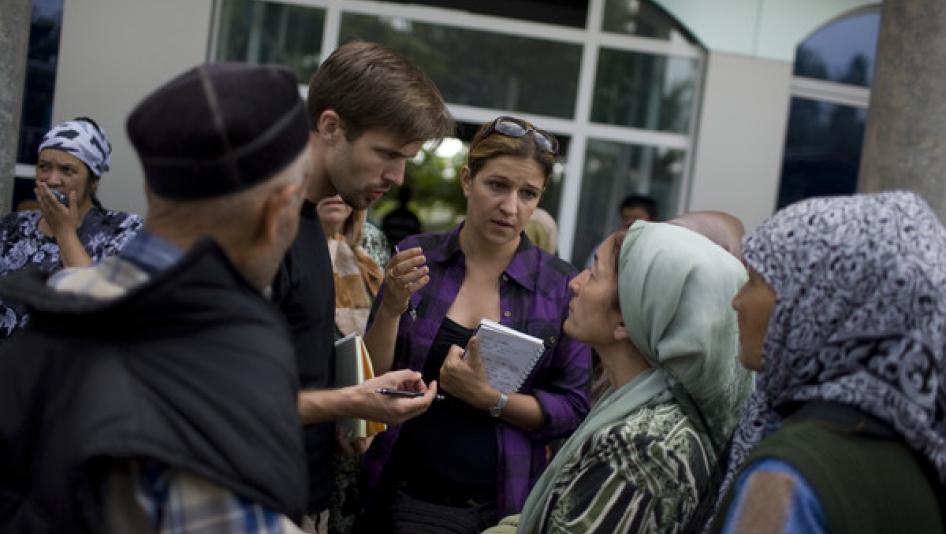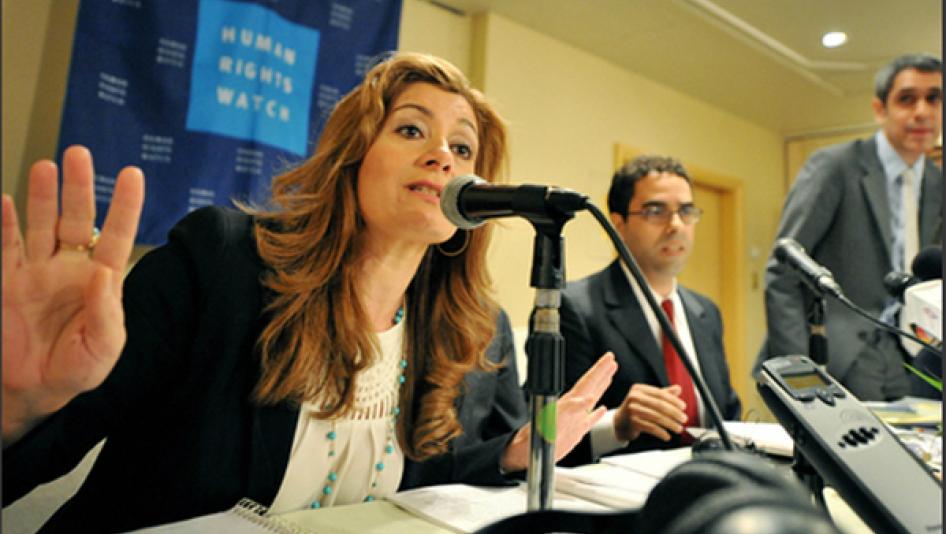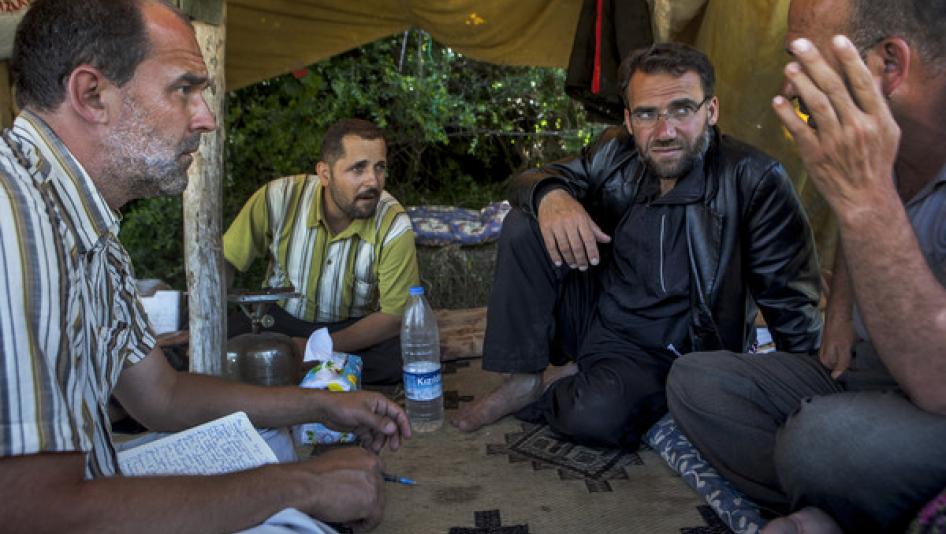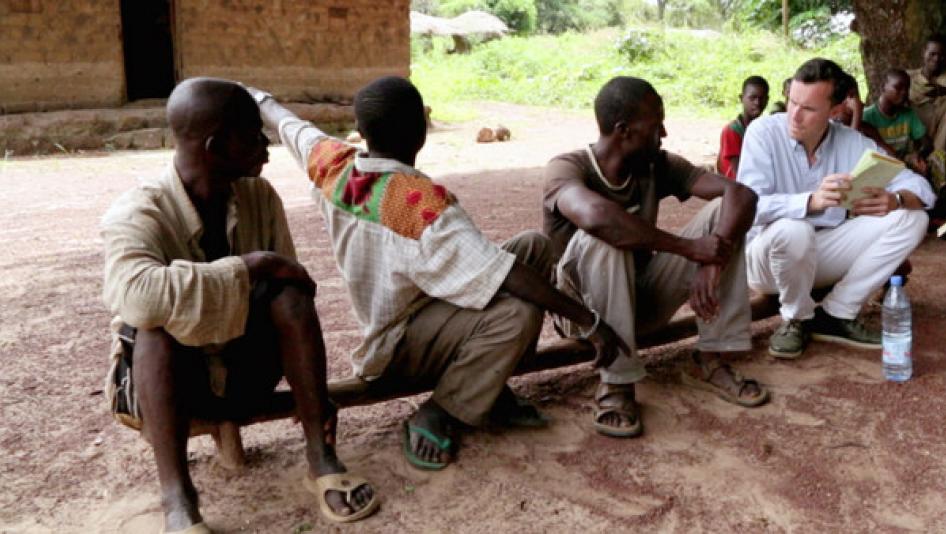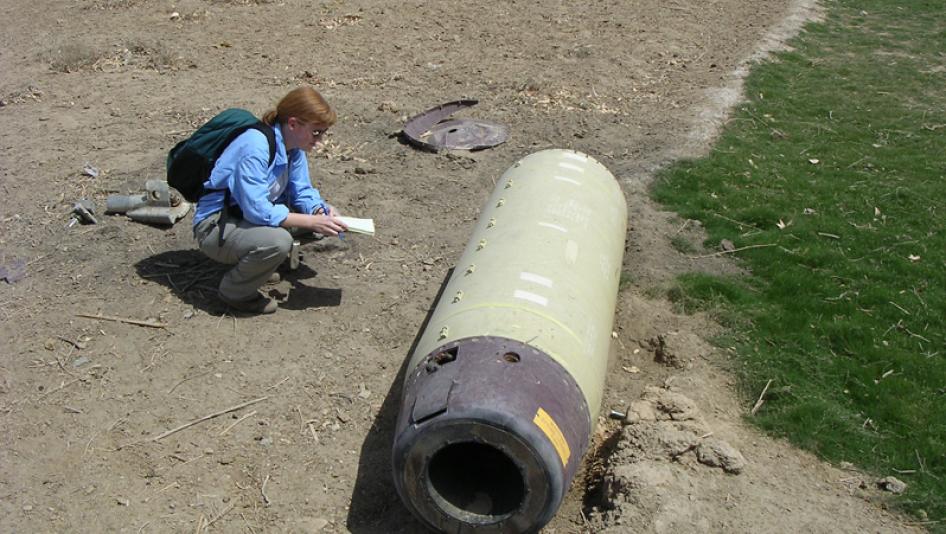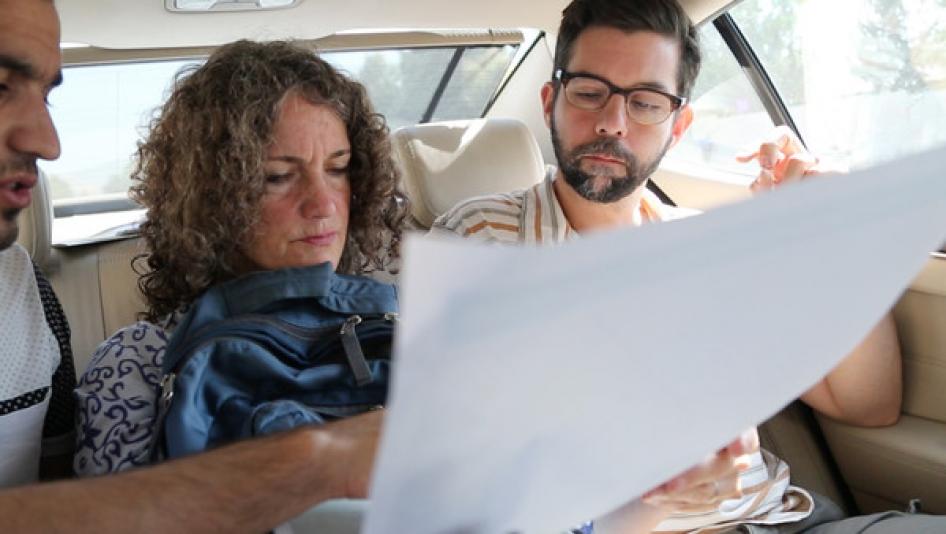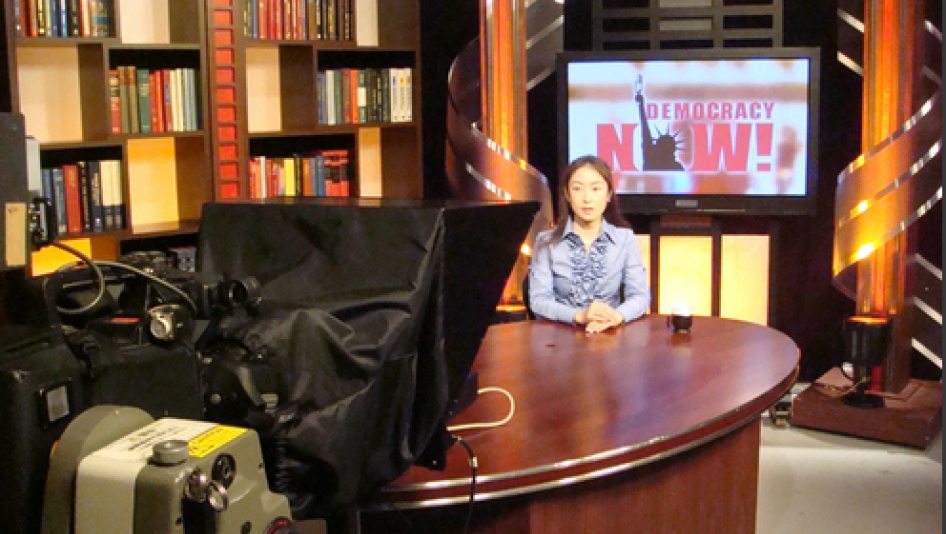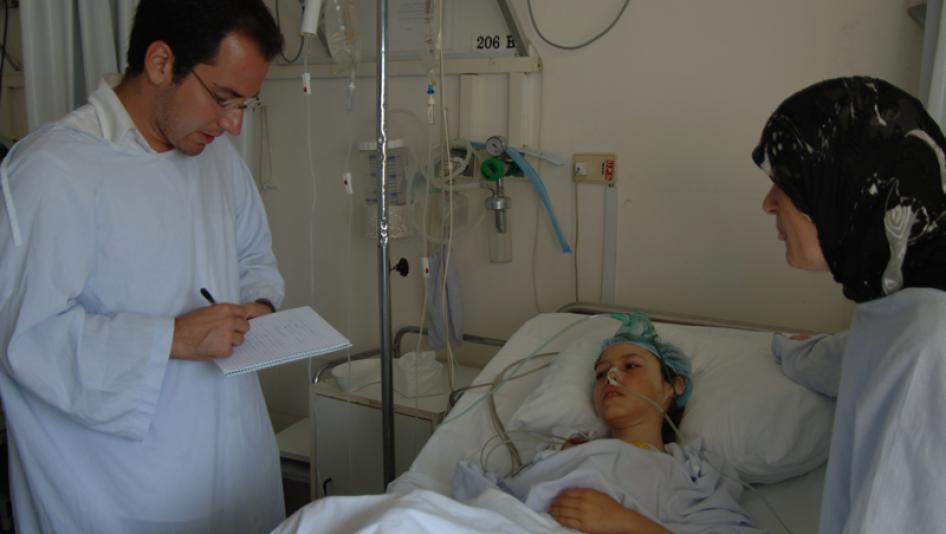Introduction
Initial Research
Interview Research
Locations
Who We Interview
How We Conduct Interviews with Victims/Witnesses
Non-Interview Research
Specific Methodological Challenges
Human Rights Watch conducts regular, systematic investigations of human rights abuses around the world. At any given time we are actively researching, reporting, and advocating for change in more than 90 countries. We choose our countries of focus, and the issues we address, based on where we think our attention is needed, and where we can make a difference. We respond to emergencies, but we also challenge entrenched, longstanding, or steadily deteriorating human rights problems.
At the heart of the work are more than 80 researchers on staff. The researchers work to an established, proven, and consistent methodology based on information gathering from a broad range of sources, and with field-based research at its core. Some of our researchers are permanently out in the field, within or close to the locations they focus on, in places as diverse as Bujumbura, Cairo, Bangkok, and Tashkent. Others work out of our main offices in New York, Berlin, Brussels, London, Johannesburg, Moscow or Washington DC. All are regularly on mission to conduct field investigations, interviewing victims and witnesses to put the human story front and center of our reporting and advocacy. They cooperate with local civil society activists, lawyers, and journalists, and they seek contacts with state and government officials. From their permanent base our researchers constantly follow developments relevant to their work through the media, the output of peer organizations and the research community, and continuous phone and email communication with trusted contacts in the local activist community.
Researching the problem goes hand-in-hand with researching the advocacy approach: our research is not just about victims and perpetrators, but about determining who can and should take responsibility for stopping rights violations and providing redress, the detailed and specific steps they need to take, and who else can bring influence and leverage to bear.
All our researchers come to Human Rights Watch with a powerful commitment to human rights and an existing expertise in their countries or issues of focus, and from backgrounds as diverse as law, journalism, local- or national-level civil society activism, and academic research. Many are seasoned professionals drawn from peer organizations. Across Human Rights Watch our researcher staff are organized both geographically and thematically: Five geographic divisions - Africa, Americas, Asia, Europe & Central Asia, and Middle East & North Africa, plus a separate program on the United States - give us our global spread. Thematic divisions and programs add to our depth and focus on specific issues within countries and regions: Arms; Business & Human Rights; Children's Rights; Disability Rights, Environmental Health Rights, Terrorism & Counterterrorism; Health & Human Rights; International Justice; Lesbian, Gay, Bisexual &Transgender Rights; Refugees; and Women's Rights. The researchers work under the supervision of divisional or program directors, and core departments such as the Legal & Policy Office and the Program Office, which ensure the highest organizational standards of accuracy, balance, and persuasiveness are consistently met.
Human Rights Watch develops its research strategies and selects its research topics based upon the guiding principles of the organization.
The initial stages of research can differ greatly when researching an emergency or rapidly developing rights violation as opposed to a long-running violation or longer-term human rights issues. During an emergency, our researchers attempt to document the violations or abuses that are occurring as quickly and thoroughly as possible; this requires researchers to be on location immediately, and we may deploy our specialists in the country or issue in question, or our dedicated emergencies researchers. For longer-term issues, our researchers deploy their existing specialization in the country or issue to conduct extensive background research, familiarizing themselves with the context and subtleties of their subject before conducting interviews with victims and witnesses.
The goals of the initial stages of research are to develop a thorough, well-rounded understanding of the incident or rights violation and to gain a strong sense of the local political, social, and cultural context of the violation. The researcher must also frame the violation as it relates to international human rights and humanitarian law. Contextualizing the violation or situation assists the researcher in the other initial stages of research: identifying potential victims and witnesses for testimony, reaching out to all actors involved with the violation, and beginning to identify advocacy targets. Communication with a local network of contacts and relevant actors is the primary method for researchers to familiarize themselves with the local conditions and gain a thorough understanding of the situation.
Human Rights Watch researchers rely heavily on communication with a network of contacts from the outset, and throughout all stages of research. Local human rights activists and civil society members are often Human Rights Watch's strongest allies and partners in our work. These contacts are essential to the researcher's efforts in identifying and contacting victims and witnesses for testimony. We also confer with other contacts such as lawyers, journalists, doctors, student groups, government officials, diplomats, representatives of international nongovernmental organizations and international experts, to exchange/solicit information and to help identify witnesses, victims, recommendations, and advocacy targets.
In addition to preliminary communication with contacts, researchers will conduct extensive background research before beginning witness or victim interviews. They examine international humanitarian law and international human rights law, domestic or local law, data from the United Nations and other international organizations, academic or policy studies, nongovernmental organization reports, and relevant media stories to gain understanding and context.
Human Rights Watch's goal with any research mission is to gain enough information about an incident, or about repeated rights violations, to create an accurate picture of what happened.
This requires not only interviewing victims but also attempting to gain the other multiple sides of the story. To do this, our researchers always try to get to specific locations where violations are known to have occurred, or are ongoing. Security conditions and time limitations can greatly affect where researchers can conduct investigations. Before every research mission, we evaluate the security risks and develop communications and security protocols. In cases of major armed conflict, researchers attempt to remain on location for as long as security will allow.
When investigating systematic or repeated human rights violations rather than specific incidents, we first conduct background research to determine the best locations for interviewing individuals affected by rights violations. Extensive literature reviews, media reports, and background interviews with experts on the topic are used to guide potential research. Local partners in human rights organizations, academia, and civil society often help Human Rights Watch identify and determine the regions within countries, districts within cities, or specific locales where researchers can encounter witnesses and victims of rights violations. Local activists also help arrange access to interviewees once they are located. Often, witnesses and victims of human rights abuses can be found grouped together in single locations such as refugee camps or hospitals.
We will often refer to existing studies or other empirical data to determine research locations. Examples of using data to guide the selection of research locations include:
- using HIV prevalence rates to determine which regions of Russia to visit to investigate access to evidence-based drug dependence treatment for injection drug users
- using school district discipline rates along with demographic statistics to select districts in Texas to visit to research corporal punishment in high schools.
There are sometimes cases where Human Rights Watch attempts to gain a broad spectrum of interviews, and we will therefore use demographic data to select a diverse set of geographical locations to conduct interviews.
Interview Research: Who We Interview
Human Rights Watch researchers conduct interviews when investigating reported human rights abuses in order to understand accurately what occurred. Human Rights Watch seeks to interview those directly involved with the abuses: victims and witnesses. In addition to understanding the reality of what has occurred, Human Rights Watch interviews victims and witnesses in order to give them an opportunity to have their voices and stories reach a wider audience. Interviewing victims and witnesses also helps Human Rights Watch develop the recommendations we address to authorities for cessation and redress of human rights abuses.
Human Rights Watch researchers often begin their research by interviewing those with direct knowledge of the rights violations that have occurred or of the relevant issues. This includes local human rights organizations and activists and members of local civil society. These initial discussions help Human Rights Watch researchers identify and locate victims and witnesses to interview. Aside from initial background discussions, our researchers will also interview a range of individuals such as representatives from local and international nongovernmental organizations, UN representatives, journalists, doctors and medical experts, lawyers and legal experts, community leaders, law enforcement officials, diplomats, and civil society leaders in order to corroborate information from witnesses and victims, and to better understand the social, political, and cultural contexts of the situation Human Rights Watch is reporting.
In addition to victims and witnesses, Human Rights Watch always attempts to contact government officials, military leaders, rebel or militia groups, or any other accused perpetrators of abuses in order to receive information, explanations and accounts of incidents, and to communicate our concerns. In many instances, requests for such interviews have been refused or have gone unanswered, however.
There have been occasions where interviews with accused perpetrators of abuses have not been conducted because of potential security risks to our researchers.
Interview Research: How We Conduct Interviews with Victims/Witnesses
Every human rights violation or incident that Human Rights Watch investigates, and every victim or witness a researcher interviews, is unique. Therefore there is no uniform interview methodology that is universally used by the organization. But the principles by which Human Rights Watch researchers conduct interviews with victims and witnesses are standard: though interview techniques may be varied or adapted for each situation, the guiding principles, such as the need to ascertain the truth, to corroborate the veracity of statements, to protect the security and dignity of witnesses, and to remain impartial, are consistent throughout the organization. Some of the most commonly employed techniques used for interviewing witnesses and victims are to conduct interviews in private settings, one-on-one with the researcher, and to focus the interview on the details of what occurred.
Conducting interviews in private both supports maintaining the witness's confidentiality and privacy and helps to avoid false statements, exaggeration, and conjecture by ensuring interviewees are making independent statements. Researchers will always attempt to ask other witnesses and victims questions about the same incidents, attempting to corroborate factual details, confirm witness accounts, expose exaggerations, or discount unverifiable statements.
One of the most commonly employed interview techniques for confirming the veracity of a statement is to focus interview questions on details. By focusing on details such as ages, names, locations, times and other descriptions, researchers can identify false or misleading statements or whether statements are about incidents that have been personally witnessed, as opposed to hearsay. Asking interviewees to repeat or clarify information that they have given earlier in the interview is another technique used to expose false statements. Researchers often ask other witnesses and victims about the same incidents to help confirm the veracity of statements. It is difficult and unlikely for multiple interviewees to present the same details about an incident if those details are false.
Our researchers are careful to avoid re-traumatizing people who have suffered serious abuses. They make sure to approach interviewees at the appropriate time and setting and are trained to communicate with sensitivity. The setting will be secure and private. The interviewee will be informed of the purpose and scope of the interview, consent will be given and the interviewee will be ensured of their anonymity and confidentiality. Interviewees will be assured that they always have the option to end the interview or not answer a question. If the researcher feels that a witness or victim is not emotionally ready to be interviewed, the interview will be cancelled or rescheduled.
Interviews are always conducted in a language in which the interviewee is fluent (usually the interviewee's first or native language). In most cases, the Human Rights Watch researcher is fluent in the language of the interview. On occasions that the researcher does not have fluency in the language or local dialect, Human Rights Watch uses consultants and interpreters; most often interpreters are local human rights activists working with the researcher and therefore are impartial and understand the nature of the interview and of Human Rights Watch's work. Interpreters and consultants are trained by Human Rights Watch to translate questions and responses verbatim so that follow-up questions can be asked when clarity is needed.
Interviews are always conducted in-person when possible. On the occasion where it is absolutely impossible to conduct an in-person interview, Human Rights Watch researchers have conducted interviews with witnesses or victims via telephone and other modes of communication. The setting or mode of the interview is always correctly noted in the published Human Rights Watch report.
Interviews are not the only form of evidence that Human Rights Watch uses during research and reporting. We conduct extensive reviews of media reports, domestic legislation, international law, policy papers, academic reports, and civil society reports during the initial stages of, and throughout, the research process. Trial materials, government reports, conviction and sentencing materials are all often used to make cases in Human Rights Watch reporting. Data collected from sources such as the UN, regional intergovernmental bodies, and domestic government agencies are also often analyzed to prove the existence and extent of human rights abuses. Examples of this include using US criminal sentencing data to prove racial discrepancies in the sentencing of juveniles to life without parole or using patient payment records from hospitals in Burundi to prove inequitable and unethical treatment of patients. There have also been instances where Human Watch Researchers have collected and analyzed primary data, such as in a report enumerating war crimes in Kosovo that contains our own analysis of trends in the data.
In the field, researchers sometimes gather information and data that are not based on interviews but on examining the location of incidents. Human Rights Watch researchers have used forensic tools to document human rights violations. Researchers have photographed bodies for injuries and scars, documented locations of destruction, documented spent ammunition casings, and measured and analyzed craters due to explosions. Human Rights Watch has also used GPS coordinates and satellite imagery to visually expose the locations of rights abuses. When documenting evidence of human rights abuses, researchers are trained to use any methods at their disposal and not to rely solely on interviews.
Detailed specific methodological challenges
Closed-Society Research
Human Rights Watch conducts research in many countries and regions that can be defined as "closed societies." Some of these countries, such as Iran or North Korea, completely close their borders to our researchers. Other "closed regions" may be in countries that are technically "open" but are regions closed to researchers due to insecurity or restrictions put in place by the authorities. Conducting research in these regions presents many challenges including identifying rights violations, gaining a thorough understanding of the local context, identifying victims and witnesses, and identifying suitable recommendations and advocacy opportunities. Security is Human Rights Watch's greatest concern, not only for our researchers, but for those with whom researchers speak. In these closed regions there is often an ongoing security threat to our contacts and to those we speak with, and maintaining their security, long after researchers have left, is our highest priority.
There are many methods that Human Rights Watch researchers employ to gather information from closed regions. Even without entering the region, researchers are still able to conduct interviews with victims and witnesses. Interviews are often conducted via telephone and, at times, through online communication. These interviews are usually used to gather background information and identify rights violations but occasionally, Human Rights Watch will use witness or victim testimony which has been gathered remotely in our reports. Researchers take great care to verify identities of the victims or witnesses and to corroborate their testimony through their lines of questioning and by comparing their information with that of other sources.
Border interviews, occurring across state or regional boundaries with witnesses who have just arrived from the closed region, are another method used to interview victims and witnesses to rights abuses. This technique has proved to be one of the most effective ways to gather information from a closed society and, at times, has been the only way to gain information about what is occurring in the country or region. Camps for refugees or displaced persons, and military or rebel group outposts are some of the locations where we carry out border interviews.
Recently, Human Rights Watch has begun to use satellite technology to expose rights abuses in closed regions. Satellite imagery is extremely effective for showing the before and after effects of major conflict, such as the destruction of villages, or mass movements of people, such as the displacement of refugees. Satellite imagery has been used when Human Rights Watch has received reports of specific locations being attacked but has not had the opportunity to enter the region to confirm these reports. Using previously taken GPS coordinates from villages reported to have been attacked, researchers have been able to purchase a series satellite images of these villages taken over a period of time. These time-stamped images give clear evidence of the before and after effects of an attack.

